I’ve just finished a blog post for the Turf Battle competition that I thought readers of this blog may find interesting, as it pertains to landscape design, the Middlebury landscape in particular. In Space, I wrote about the hierarchy of outdoor spaces on campus, and how the master plan for Middlebury sees our outdoor spaces. I found it fascinating to research, as most of my landscape design courses I took never focused on such large and lofty areas such as these. It’s a quick read, hope you enjoy it.
Landscape
Annual Review
Regular blog readers (all four of you or so) probably don’t realize I can read about you as well. Through the wonders of an add-in on the blog called Blog Stats, I can see not only how many people are reading pages on this blog, but what pages they are hitting. It can be kinda funny.
I can use the information almost like a forecast. My post a year or two ago on Forecasting a Nor’easter tends to get many page views as a storm comes up the coast-it’s one of the only places where you can look up exactly what that “benchmark” is the forecasters are always mentioning. Similary, do a web search on Pagoda Dogwood, and Google will probably lead you here.
It can be humbling, though. Some of my favorite posts have been the least popular, showing the lowest number of page views. Like Black Eyed Susan-one of my favorite plants, and favorite posts. Next to no one read that. Or Plants of a Mis-Spent Youth-the secret I barely want to tell anyone about how I’m filling Middlebury with unusual plants. My very least popular posts, though, have been on Annuals.
We don’t plant a lot of annuals at Middlebury-it’s a space and time thing. It’s best to plant annuals at the end of May and beginning of June, when our department is busy with Commencement and reunion. And with 200 acres, where would we stop? But we do have a couple of prime locations where annuals really brighten an otherwise boring area, and they’re fun to plant. In the past I’ve written about what we planted, thinking that plant geeks like me care, and would want to read about them. Well, site stats say they don’t.
So I skipped it this year. Our normal plantings on Old Chapel Road and the front of Johnson were as popular as always, based on comments from people walking past, but I never posted about what they were. Unlike my own garden, where I sure as hell wished I’d kept track of all the names of the daylilies I’ve planted, I do keep careful track of what we plant at Camp Midd, and naturally I watch carefully. So this year, I thought I’d actually review what we planted, and how well they grew.
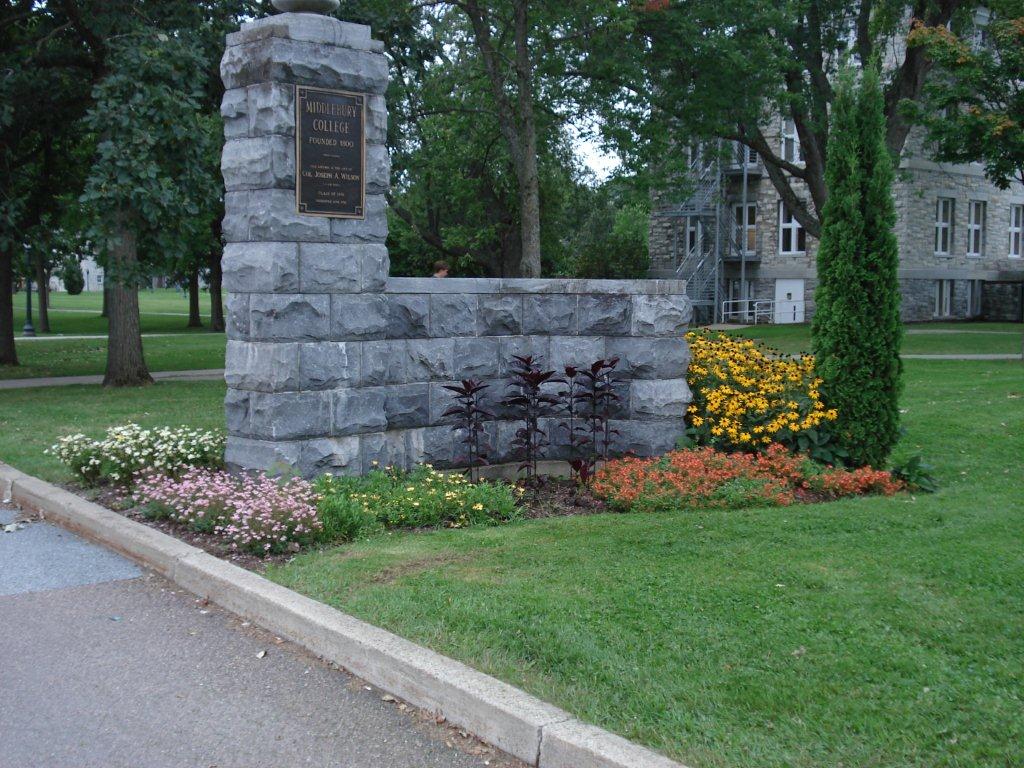
I was in the retail garden center business long enough to see so many plants come and go I couldn’t even keep track of them. Gardeners are trained well to plant something new, something exciting. My new role as campus horticulturist requires consistency. I need to know that what I’m spending our budget on is going to work, is going to grow and flower for reunion, language school in the summer, and last through fall family weekend in September. But the plant geek in me likes new things, so clearly I’ve been well trained. And don’t forget the marketing in greenhouses-plants are bred now to look good in little pots and six packs very early, so they sell well. And nobody writes or reviews how well they grow once they’re out of they’re coddled existence.
(Side note: Greenhouses are not a coddled existence, but it is a good phrase anyways. During my first experiecence with commercial greenhouse production I couldn’t believe how harsh the greenhouse magician treated the plants. In fact, I wasn’t even allowed to water. The worst thing to do to a greenhouse is to water it. Most plants in greenhouses die from fungus and rot, the pestilence of over-watering. My boss would smile upon casting his gaze at a greenhouse full of plants just starting to wilt. You can fix that with water. You can’t fix a root rot so easily.)
I have some old faithful plants I put into the annual plantings every year here. Mostly yellow and gold. The official Middlebury color is a very dark blue, which make it easy for a color wheel challenged horticulturist to play off of that with bright yellows and golds of summer flowers. My wife wanted to paint our house a dark blue, and brought the bloom of the Tiger Lily that came planted in front of our house down to the paint store to pick the right shade-she’s taught me more about color than four years of Plant and Soil Science at UVM ever did. Sadly, there is no Middlebury Dark Blue flower, at least none I know. That’s why the Middlebury College sign across from Admissions gets yellow and gold flowers. (including Black Eyed Susan, you did read that post, right?)
This year, at the end of Old Chapel Road, by the stone pillars, I went with some standbys, and some new flowers. Most impressive this year were the Diascias, ordinarily a finicky flower. I tend to think fo them like a pansy, better in the cool springs and falls, not so great in the heat of the summer. This one a banner year, though, with a pink Darla Appleblossom from Goldfisch blooming all summer long next to the road

and a great Darla Orange Diascia from Goldfisch in the front north side.
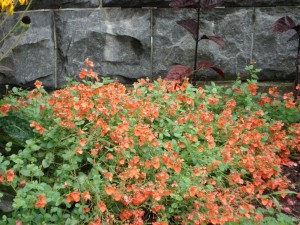
Something everyone should plant more of is an annual with a terrible name, Scaevola. Proven Winners is trying to give it the rather bland common name of Fan Flower, so I guess that’s better than the latin. I used to love selling this plant in a hanging basket, as it’s as nearly foolproof . I’ve seen this plant go into full wilt, hanging over the sides of the pot looking for the compost bin, but with a quick drink of water covered in full blooms in 3 days. Mostly seen in a pale-ish blue, this year I used a really pretty white, and I never drove past and saw this plant out of blooms.
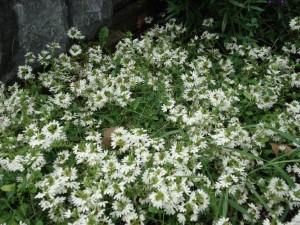
A flower I always fall in love with in the greenhouse, and a good contrast to Middlebury blue is Marguerite Daisy. Not a great choice for annual beds, though, at least not for us. Many annuals cycle-blooms like mad for several weeks, then next to none while it sets seed (or thinks it does, as most hybrids probably don’t anymore). In a container, or in the hands of someone with more time on their hands than I, this plant will do well, as snipping off dead flowers keeps it blooming well. I like the Vanilla Butterfly cultivar from Proven Winters, in a nice pale yellow. It also comes in a gaudier bright yellow, and a pale pink that only looks good for 3 days in the greenhouse, and then never again. Here’s the Vanilla Butterfly on a good week. Look at the picture above of the Middlebury College sign for a bad week. Look hard, it’s in there.
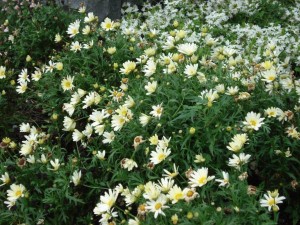
Speaking of falling in love in the greenhouse, every year for the last several I’ve been planting Angelonia, Angelonia angustifolia. I fall for the Proven Winners ‘Angelface Blue’, even though they don’t trust us with the latin, and are calling it Summer Snapdragon. This is beautiful in a little 4″ pot, all upright and full of dark blue, almost purple blooms. It does sort of look like a snapdragon, with a couple of bloom spikes sticking up across the greenhouse bench. They get planted, and promptly fall over on the ground, staying there for several weeks until the base of the plant sends reinforcements. I’ll probably keep planting it, though, as there is nothing like a summer romance.
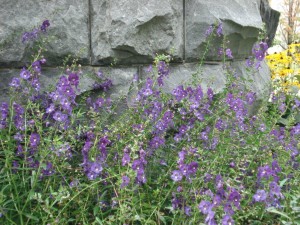
There were two dissapointments in the bed this year, one of which I should have known better. Osteospermum (latin and common name this time) is another of those very popular spring greenhouse flowers, and it’s been getting the royal treatment from hybridizers ever since. The problem is that they are like a pansy, only worse, gone mad, only blooming in the spring and fall, and going on vacation in the heat of the summer. We planted a Proven Winner called Lemon Symphony, in a nice pale yellow with a purple (!) eye. It was so sad looking at picture time in late August, I didn’t even take its picture.
Another plant that does not work in a planting bed turned out to be a foliage plant, Pseuderanthemum ‘Black Varnish’. Great cultivar name, as the thick glossy leaves are a dark, almost black red. This would be a great plant in a container as a focal point, standing tall in the background. Massed together in a outdoor bed, with no side shoots, it just looked a little silly. Not that there is anything wrong with that. Maybe if I’d pinched the tops of the plants off in early July to promote branching they might have filled out some.
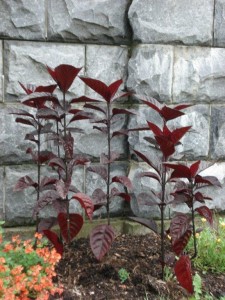
Not dissapointing, but not thrilling, was a Calibrachoa called ‘Noa Yellow’. The common name is Million Bells, for many tiny petunia shaped flowers that cover the annual, but Million Bells may be a Proven Winner trademarked name. Some of the Calibrachoas grow like crazy, while some never really grow much after their greenhouse sojurn. ‘Noa Yellow’ ran the middle course, blooming well, but never really expanding out into the garden to fill space. Chalk it up to another plant for containers.
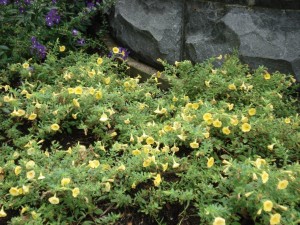
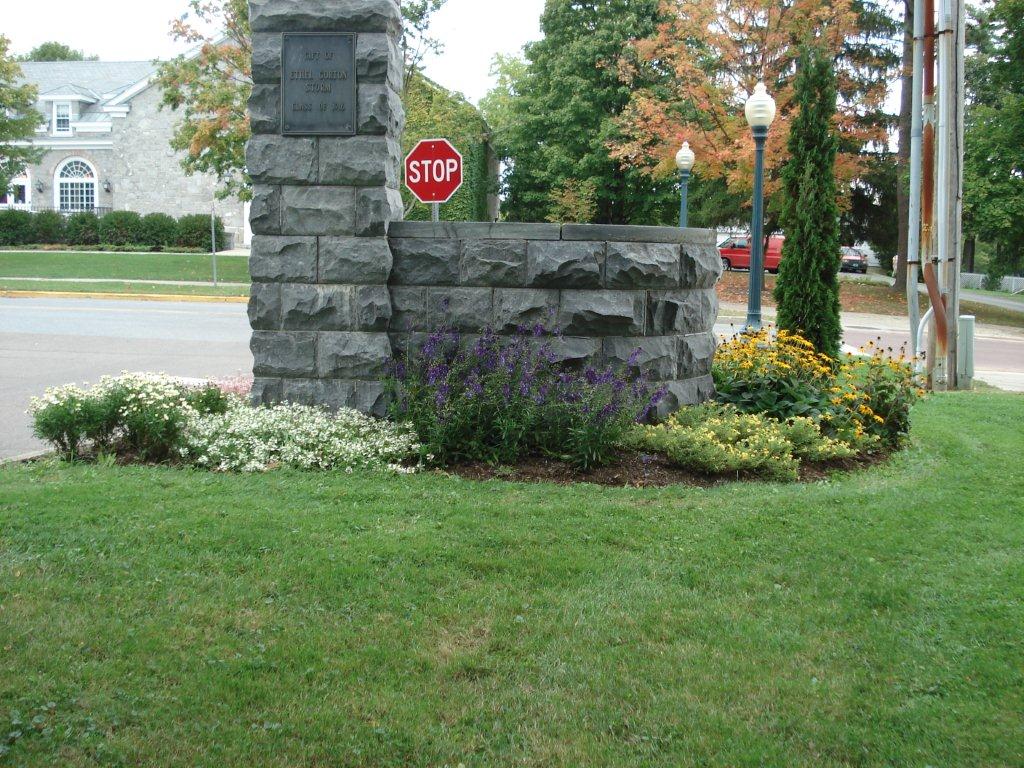
Sustainable Landscaping
While doing a post on the Sustainable Sites Initiative for the Atwater Landscape contest blog Turf Battle I’d remembered I also wanted to write about a homeowner version of this document called Landscape for Life. I first read about this project at the wonderful Garden Rant blog, then immediately went to read the document. I’d been following the work of the Sustainable Sites inititive for a while, and am over-joyed to see a less ‘industrial’ application.
Like the Sustainable Sites website, the Landscape for Life website is a great resource in an of itself, but the true reading is found in the large document, available for download. Highly recommended winter reading for your inner gardener.
Tree Hazards and Removals
How do we decide when to remove a tree?
It’s the hardest part of our job here in the landscape department, deciding when to give up on one of our trees, and schedule its removal. Some of our oldest trees on campus have their life span measured not in years, but in centuries, so removing one of our noble specimens is very difficult. Even taking down a little young tree makes us sad. We obviously can’t remove a tree just because it doesn’t look quite right, or is in an inconvenient location-our bar is set higher than that. We look at tree risk, the factors that make a tree hazardous.
Students in my Winter Term class learned a simple definition of a hazard tree. A tree is a hazard if it has something to fall on. A tree needs a target to make this dubious list. Sadly, this isn’t much of a guide for us on campus. As you’ve probably noticed, we’re a target rich environment-between buildings, other trees, sidewalks, roads, power transmission lines, sculptures, squirrels, bike racks, students, staff, parked cars, professors, and light poles, we’ve got our share. We certainly prioritize them, and may speed removal of certain hazards quicker than others, but we assume that all trees on campus need to be watched pretty closely.
This fall the landscape department made a special project out of looking for hazardous trees. We surveyed about 2/3 of our 2275 mapped trees, specifically looking for hazardous defects, such as a crack or a split, something that could potentially make the tree fail and injure someone or something. And while it is certainly true that if you start looking for problems you can find them, in our case we identified only 120 trees that met our definition of hazardous, less than 5% of our population.
Of these 120 trees or so, 60% are maples, with Sugar Maple itself making up 40% of the hazard trees, double their representation in the population, as maples make up about 30% of our total. This is shocking, for a state whose tree is the Sugar maple, but not surprising, as Maples, Sugar in particular, are very intolerant to urban conditions, root compaction being one of the worst.
A hazardous tree comes in varying degrees. It’s like having a history of heart trouble in your family-being a hazardous tree is not a sentence of doom, just a cause for, well, not alarm, but extra vigilance. The majority of our hazardous trees will have risks mitigated by good care, such as corrective pruning, cabling, bracing, and simply close monitoring.
There are, of course, trees where even the best of solutions aren’t enough. Generally, these are trees arborists would call ‘over-mature’, or past their expected life span. While a tree in the woods can slowly fall apart and die without any thought to dignity, on campus we can’t wait for catastrophe to happen. Unfortunately, as would be expected, the majority of risk trees are in the older areas of campus, places where similar species and ages are planted together. A good example of this would be the east side of Voter Hall, where several large Silver Maples have serious problems, but make up the majority of the tree canopy.
So of our 120 hazard trees on campus, 6 are slated for removal this year. These trees contain flaws so egregious that no amount of fixing would make them safe, so it is time to let them go. As is our custom most years, we try to schedule large tree removals over Holiday break-chainsaw and chipper noise during finals isn’t conductive to study. I’ll post some pictures in the next couple of days to show the trees we are removing and why. I think you’ll find it interesting, and you all may want a chance to say goodbye.
Some Late Fall Color
We’re in the bitter end of fall here, at least in terms of foliage. To me, this is when trees really start to shine. Maybe it’s all the bare trees nearby, or the perpetually cloudy skies, but the remaining foliage seems to take on an extra glow, or maybe urgency. Foliage colors that wouldn’t have turned a head 2 weeks ago now looks spectacular in the dying season, like the russet brown of the Star Magnolia behind Voter Hall. Sunlight breaking through the clouds acts like a highlighter pen. The wet cold makes any color seem all the more special. Here’s a little slideshow of trees and some shrubs that turned my head late last week.
[nggallery id=44]
Best Addition to the Landscape 2010
Everybody has been talking about it, and I know I’m late to the party in posting a picture of the mural on the back of Wright Theater. What I wanted to post, though, was not the best picture of the mural out there, but a picture of the mural in the context of the greater surrounding landscape. I only wish and dream that someday a landscape I put in would have even a fraction of the power this piece has to transform a space. Thanks to Sabra, Kate, and everybody else who made the project happen.
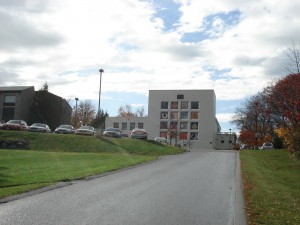
Shade Plantings, and a new Service Building look
Landscape books often write about shade as a “problem”, or give chapters on “solutions” for shady locations. I think that’s crazy talk.
Shade plantings require a slightly different mindset, like stepping two feet to the left and looking at the world slightly skewed. Full sun is luxuriant-throw anything in there, and it’s bound to look good. How can you go wrong with something in bloom? But shade draws a sharper line, and making dark locations look good without relying on a full palette of blooming plants requires looking at other properties of your plants, things gardeners and landscapers take for granted in the light of day. Master planting in the shade, and the required skills will make your sun plantings all that more rich and interesting.
Like the color green. You know green, it’s all that stuff beneath the blooms on your Coneflower. Green is a color too, and without the laziness of the myriad of colors of flowers to rely upon, shade draws out an appreciation of the multiple hues of greeen. Or how about texture? Think of the huge leaves of hosta, and play that against a finely textured grass. It’s about making the plants talk about what they are for the entire season, not just the couple of weeks they are in bloom.
I bring all of this up because of one of my favorite landscape jobs this year, maybe of my entire 4+ years here so far. The service building doesn’t have a glorious name (how could it?), and the north side had an overgrown thicket of juniper, hating life in the shade, and Bayberry, a nice plant prone to suckering from the roots to over-fill any area given it. Yearly our department was asked to rediscover the sidewalk leading up to the main door, as the shrubbery in the beds nearby were eating any free space the path may have had. Once again I failed at a before picture. I actually took one this time, and deleted it by accident from my cell phone. Trust me, it was a jungle.

Here’s the after picture. All of what you see was a thicket, including the grass now on the left side underneath the White Pine. The large tree on the left is a Red Maple, which strangely enough turns a bright yellow every fall, instead of the Red of it’s name. They do that sometimes. The bench by the door was already there, and frequently used by my wife on her breaks from the Grille working the night shift, so that was staying. (And I would have gotten to this landscape eventually anyway, but having her out there a lot certainly did move it up on my priority list. Work until 3 in the morning, I figure you deserve a nice garden to relax in…)
This was also the first landscape job where I got to work with Brad Lambert, our resident mason in facilities. Really nice guy, and more than willing to put up with my crazy ideas. The landscape had a BFR for no known reason right at the end of the walk to the front door, and, rather than move it, we decided to build a small stone wall off from it, and we put a dwarf Weeping Hemlock (‘Cole’s Prostrate’) right at the top to cascade off of the new wall. Less work to build the wall then move the 500 pound rock out of the way.
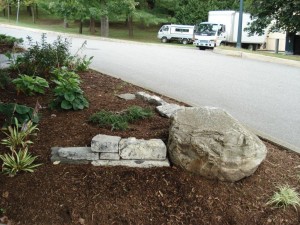
Brad and I were having fun, so he stuck around and made a stone path through part of the garden. Someone stopped by, probably going upstairs to Human Resources, and leaned their bike against the wall, so a bike rack seemed in order.
We had a little extra stone, so Brad jazzed up the bench some too.
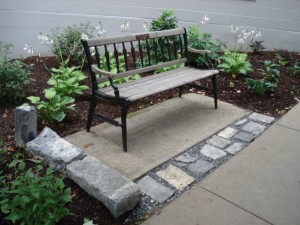
The stone is Panton stone, originally used as the low wall around the deck at Proctor, and we stole recycled it from storage.
Other woody plants in there include an Upright Yew, in an attempt to screen the parking lot from the front door, and some “Landmark” Rhododendron, another great shade evergreen with red flowers in the early spring. I haven’t planted this one before, but I’ve had good luck with other small leaved rhodies, so I have hope. There is also dwarf Japanese Golden Yew, Taxus cuspidata ‘Nana Aurescens’. This plant stays gold all winter long, adding some nice color near the walkway.
We left a woody plant in there, tucked behind the bench. I don’t even recognize it when I first started working at Middlebury-it’s not really supposed to live this far north.
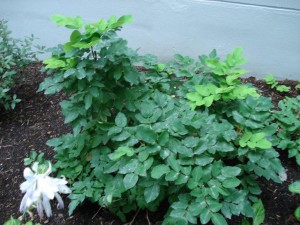
Oregon Grape Holly, Mahonia aquifolium, is a solid Zone 5 plant, though some people say Zone 4 with protection, which this location certainly has. Native to the west coast, this Barberry cousin has chains of yellow blooms in the early spring (the state flower of Oregon no less), and purple grape shaped fruit in the fall. Edible, you can make jam from it, but I wonder if it’s one of those fruits that needs copious white sugar to make it palatable. The evergreen leaves are shaped like holly, and are used as such by florists.
The plant fun I had here, though, was in the perennials. Hostas are the backbone, their thick large leaves giving a coarse texture to play off of in the rest of the garden. Current plant breeding has given the hosta genus much more interest than the old fashioned green and white leaf with purple flowers your grandmother ringed all of her trees with back in the 60’s.
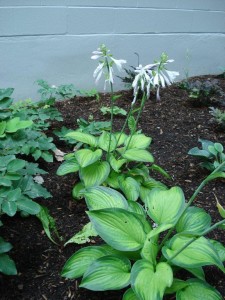
We used ‘Guacamole, an apple green and gold leaf with large white flowers late in the summer, scenting the air with a jasmine fragrance, along with my favorite scented Hosta, ‘Royal Standard’. ‘Cherry Berry’ is another hosta, put next to the pathway, with spear shaped gold and green leaves, but really planted for their dark purple blooms, followed by masses of little red seeds, hence the name.
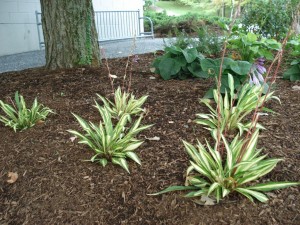
Another hosta, massed underneath the memorial Red Horsechestnut at the end of the bed is ‘Gold Standard’, once again with gold and green leaves. This is the same hosta we planted underneath the giant Sycamore at the Deanery on College Street.
Other plants are sprinkled in there as well, included a cool variegated Carex, ‘Evergold’, and some red leaved Snakeroot, Cimicifuga ‘Hillside Black Beauty’. We also stuck in some Heuchera, a new cultivar called ‘Mocha’, and a great Japanese Painted Fern named ‘Ghost’. We didn’t forget about spring, sticking in a perennial Forget me Not with the strange latin name of Brunnera, a.k.a. Siberian Bugloss. The forget me not everybody knows is Myosotis, but that’s a biennial, and hard to manage in commericial landscapes (it gets weeded and pulled quite a bit) The Siberian Bugloss has large dark leaves like a hosta, and seemingly live forever.
My favorite shade plant is next to the walkway-it’s small blooms in the fall need to be seen closely. And once you’ve looked, you’re hooked. Tiny speckled purple blooms like tiny orchids cover the plant all fall. The name, though, is unfortunate-Toad Lily. Let’s go all Latin on it, though, and call it Tricyrtis. The speckles on the blooms and leaves may make it look like a toad, but that’s rather silly. Native to Eastern Asia, from Nepal to Japan, even to the Philippines. Tricyrtis is in the Lily family, and needs shade to thrive in the south, but this far north does fine in quite a bit of sun, given proper moisture. It is only hardy to Zone 5, but I’d try it elsewhere, given sufficent snow cover. The cultivar we used is ‘Gilt Edge’, featuring gold ringed leaves all summer long.
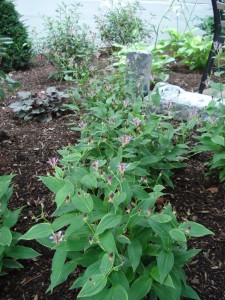
Tree Planting 2010
Of all the work we do here in the landscape department, some of the best is the tree planting.
Think of our landscape at Middlebury as a living organism, changing and evolving. Trees have a lifespan, like us, only measured not in decades but hopefully in centuries, for the best and strongest. Site vagaries not withstanding, most species live for a similar amount of time. A mad rush of planting one year will mean that down the road a large hole may develop in the landscape, as the same aged trees all need replacing at the same time. Take, for instance, some work being done at Utah State University.
The main quad at Utah State is lined with 80 year old Norway maples, which in Utah live about 60-80 years. Plans are underway to replant the green, and to remove the Norways before they fail. This has met with some resistance, probably based more on disappointment, as the look of a beloved quad radically changes in the space of a couple short years.
We started our tree planting this year on Arbor Day, thanks to Hilary Platt and Chelsea Ward-Waller, two of my students from Winter Term, and the driving force behind getting Middlebury to become a Tree Campus. Many students helped plant trees around Bi-Hall, and near Coffrin. The focus for this area was to help define some of the space around Bi-Hall Park, as well as planting in between Coffrin and Bi-Hall to help with storm water abatement. We used Sweet Gum there, Nyssa sylvatica, and a variety of other native trees nearby, such as Hop Hornbeam, Scarlet Oak, Red Oak, and Ohio Buckeye.
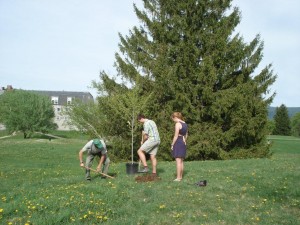
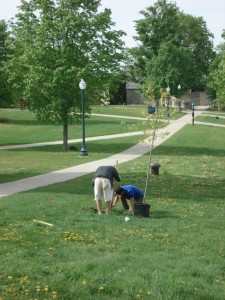
The second focus of tree planting this year happened later, after the rush of commencement and reunion. I enjoy this so much so I almost don’t want to tell of it.
Part of a happy and sustainable campus landscape involves diversity. Having as many different species of trees as possible ensures that should the next insect (Asian Longhorn Beetle, Emerald Ash Borer) or disease come to campus, large sections of our tree population won’t get wiped out, like the aging Norway maples at Utah State.
So I prowl nurseries and garden centers, looking for healthy plants that will do well on our campus. With such a varied landscape, it isn’t difficult to find a spot to tuck in some type of tree somewhere. We focused this year on areas of the campus lacking in tree color, and used ornamental flowering varieties of trees to liven up otherwise very static green locations. An example of this is a small section of lawn right to the north of Painter Hall.
While not a large area, comparatively, it was large enough for three small flowering trees, set in a triangle. One was a Butterflies Magnolia, small yellow flowers in early spring. Later in June will come flowers from the Yellowwood nearby, followed by a small tree in bloom now, a Heptacodium, Seven Sons Flower. More on that species in a later post-it’s spectacular.
Other areas planted include North of Warner Science, where many over-mature Sugar maples are slowly showing the effects of time, as well as along the east side of Hepburn Road, and North of Gifford.

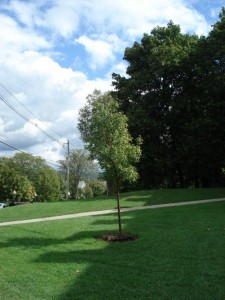
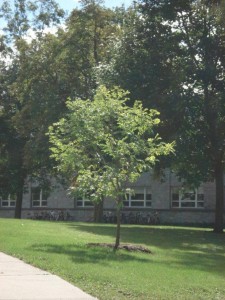
Other fun varieties planted were a “Discovery” hybird Elm, Red Obelisk Beech, “Katsura” Japanese Maple, Kousa Dogwood, and Yellow Birch (the kind they make Birch Beer from). 4 Different varieties of Magnolia were planted, one red, one pink, and two yellow. In all, 32 trees have been planted so far, and a couple more are still on the way. The Tree Karma count? Not exactly sure, with all the storm damage, but I’m thinking it’s still holding at 3.5 to 1 or so.
New Planting for Pearson Hall
One of my frequent failings in landscaping is my overall excitement when starting a job, especially here at Middlebury. So much of the work we do in the department for new plantings is ripping out large, overgrown, outdated landscape shrubs. Crank up the chainsaw, get the backhoe in position, and dive right in. The failing? I never stop, take a deep breath, and take some interesting ‘before’ pictures.
You’ll just have to trust us. The east (Battell beach) side of Pearson Hall consisted of 8′ evergreen yew hedges, smashed in the center from snow over the last several winters, with a large Burning Bush sticking out of the center, easily reaching into the second story of the building. I’m sure it was all quite lovely many years ago, but foundation plantings of that era relied overmuch on frequent clipping and shearing to maintain proper size, and even then, can only be maintained at manageable levels for so long.
(Most shrubs need to grow, of course, and lose their inner leaves or needles as time goes on. Even if you clip most of a yew back each year, that new inch of so adds up over the decades. The only exception I have heard to this rule is boxwood hedges around temples in Japan, pruned to the same exact shape for so long that a child can walk atop, the growth being so dense and congested.)
Many of the landscapes we’ve redone over the last five years have been that of almost total removal, with smaller, more manageable plantings at key locations. Not only does this lower maintenance, but, if you haven’t noticed, we’ve got some spectacular buildings on campus, and removing the multistory vegetation surrounding them allows the architecture to shine like the day it was born.
Pearson Hall was like that. A great building, hidden in plain sight. The challenge here, though, was that what we call ‘north campus’ is relatively plain,views notwithstanding. So the goal was to make a great planting, bring some color to a new area of campus, while still showing off the facade of Pearson. Dave Berthiaume, the crew chief for North campus, and I made several sketches of the front entrance, trying and failing to install a flower garden and show a building at the same time. Finally, we came up with the idea to pull the planting out, and put all the color in front of the building, in a new bed next to the sidewalk.
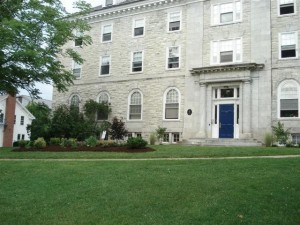
Not the greatest picture, but let’s just go with it. On either side of the door are two large shrubs, Seven Son Flower, surrounded by Mugo Pine (hopefully a dwarf variety, but one should never turn their back on a Mugo Pine.) The large shrubs will grow up and over the door, framing the entrance, but not overpower the building.
It’s the bed out front with all the color. The little red thing in the middle is actually a tree, a Japanese Maple. Readers from the south may not understand how special this is to us up here, but we love the red leaves, and try and fill the few microclimates we have available to us with this little marginally hardy tree. And imagine the red leaves in front of the building. It’ll get about 12′ tall and wide in the north country here, 20’+ further south.
Surrounding the little tree are some shrubs, and filling the holes in between are perennials. It’s a trick I use all over campus. One of the secrets to landscaping is a rule: If it looks good when it goes in, it’s too crowded. Trees and shrubs need room, more room than impatient idiots like me want to give them, so instead of wasting plants I give them proper room, and fill the spaces in between with perennials. As the shrubs grow, the perennials can be dug and divided, moved forward in the bed, or put somewhere else on campus.
Even with all of the flowers gone some day, the shrubs Dave and I picked will easily stand on their own. A couple of dwarf conifers anchor either end. A ‘Jane Kluis’ Japanese Red Pine, and one of my favorites, a ‘Sherwood Frost’ Arborvitae, like the White Cedar in the swamps around here, but with new growth emerging a snow white.
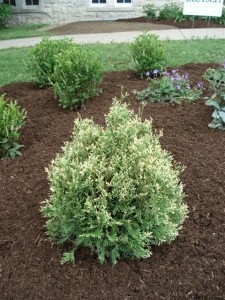
A couple of deciduous shrubs round out the structure, a blue leafed form of Fothergilla (‘Blue Shadow’), and another favorite of mine, Compact Summersweet.


The rest of the space is filled with perennials. It is tricky to buy perennials for a planting. The temptation is to grab everything that looks good, thereby assuring a glorious two or three weeks of color, and a lot of green leaves the rest of the summer. We tried to pick a broad range of plant times, but the German language school in session when we planted this may have a bit of a bonus.
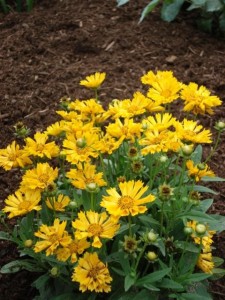
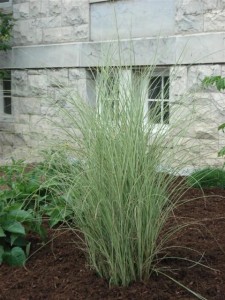
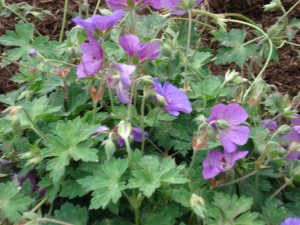
There is more in there, but I took the best pictures. I keep obsessive records on what we plant, like what I wish I’d done at my own house (50+ varieties of daylilies, some with names…), so if you ever have the need to know what something is, just get in touch.
More Vandalism
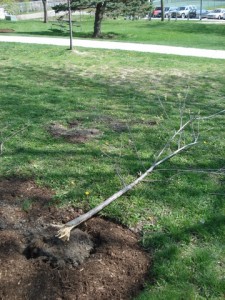
I read with interest the recent article in the Middlebury Campus on the increase in vandalism this year, as I completely agree. We’ve recently lost another tree to senseless idiocy, this one a rare Silverbell. We’d only planted this tree about a year and a half ago, and it was ripped up out of the ground about 2 weeks before it was due to flower. I could see the little flower buds shriveling up and dying right before my eyes. Not only was this tree ripped up out of the ground, but it was snapped in half at the base as well, I guess in case the first injustice wasn’t enough. This was outside of Allen Hall.
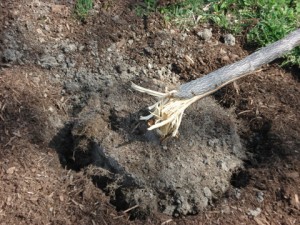
That same weekend, someone felt the need to do a little pruning on a paper birch outside of Battell.
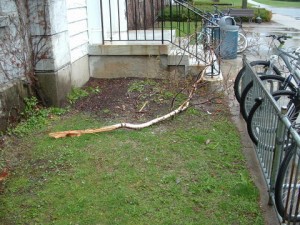
Maybe what concerns me the most is the possibility that, because most of the plant vandalism seems to be taking place outside of freshman dorms, we may be in for 3 more years of this. Once again, any ideas are welcome on how to fix this as a community.
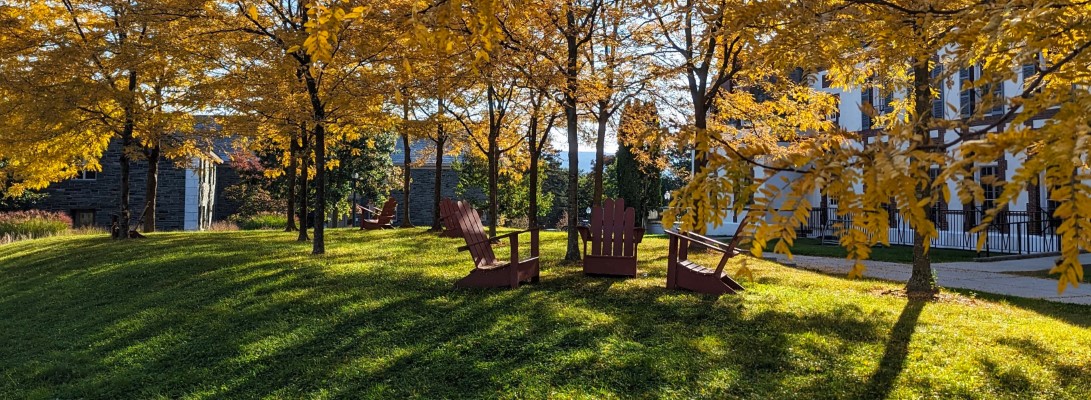
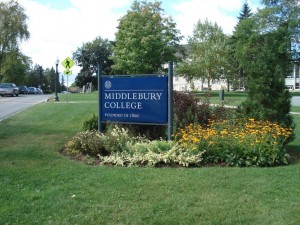
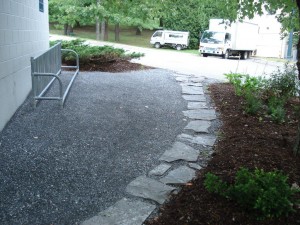
You must be logged in to post a comment.